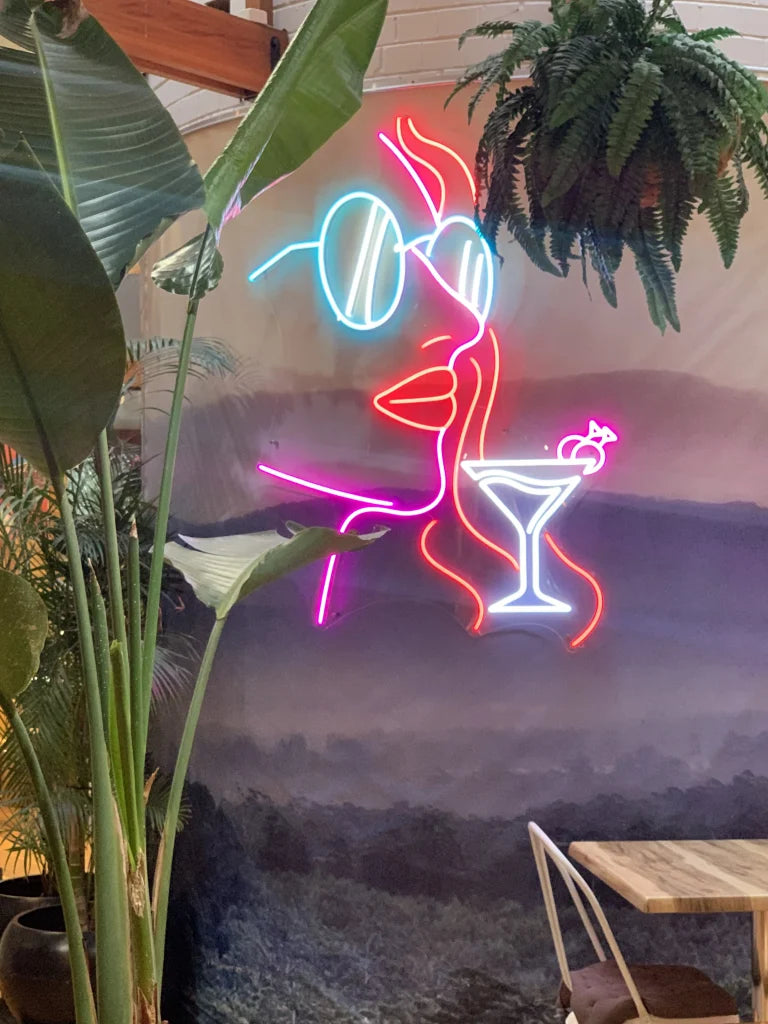Bar signs play a crucial role in the hospitality industry, serving as visual communication tools that convey essential information to patrons. They come in various forms, from illuminated neon signs to rustic wooden plaques, each designed to attract customers, inform them of services, and create an ambiance that reflects the establishment’s identity. This essay will explore the different types of bar signs, their purposes, designs, and cultural significance.
Types of Bar Signs
Bar signs can be categorized into several types, each serving a unique function. Here are some of the most common types:
-
Exterior Signs
- Neon Signs: These vibrant and colorful bar signs are often associated with nightlife. They attract attention with their glowing lights and can advertise the bar’s name, specialty drinks, or theme. Neon signs are often seen in urban settings and are synonymous with entertainment districts.
- A-Frame Signs: Also known as sandwich boards, these are placed outside the bar to catch the attention of passersby. They can display daily specials, events, or promotions. A-frame signs are versatile and can be easily changed to reflect current offerings.
- Projector Signs: Some bars use projectors to display dynamic images or messages. These signs can showcase promotional videos, themed graphics, or live social media feeds, creating an engaging environment for potential customers.
-
Interior Signs
- Menu Boards: Menu boards are essential for informing customers about the drinks and food available. They can be chalkboards, digital screens, or printed menus. The design often reflects the bar’s theme and may include graphics to enhance visual appeal.
- Directional Signs: These signs help guide customers to different areas of the bar, such as restrooms, dance floors, or outdoor patios. They are crucial in larger establishments where navigation may be challenging.
- Wall Art and Murals: Some bars choose to decorate their walls with artistic signs or murals that reflect their identity. These pieces often tell a story or evoke a particular mood, contributing to the overall atmosphere of the venue.
-
Regulatory Signs
- Alcohol License Signage: Bars are required to display their liquor license prominently. This sign reassures customers that the establishment complies with local laws and regulations.
- Age Restriction Signs: To prevent underage drinking, bars must display signs indicating that patrons must be of a certain age to enter or purchase alcohol. These signs are crucial for maintaining compliance with legal regulations.
Purposes of Bar Signs

Bar signs serve several key purposes, including:
-
Attracting Customers: The primary purpose of many bar signs is to attract attention. Bright colors, unique designs, and eye-catching messages can draw potential customers into the establishment. A well-designed sign can create curiosity and encourage people to stop and explore.
-
Communicating Information: Bar signs inform customers about various aspects of the establishment, including menu items, daily specials, events, and promotions. Clear communication helps customers make informed choices and enhances their overall experience.
-
Establishing Identity: The design and style of bar signs contribute to the establishment's branding and identity. A cozy, rustic bar may opt for wooden signs with handwritten fonts, while a modern cocktail lounge may favor sleek, minimalistic designs. The signage reflects the bar's theme and target audience.
-
Creating Atmosphere: Signs contribute to the overall ambiance of the bar. They can evoke emotions and set the tone for the experience. For example, a beach-themed bar may use vibrant colors and tropical motifs, while a speakeasy-style bar might feature vintage signs and muted lighting.
-
Regulatory Compliance: Regulatory signs ensure that bars comply with local laws and regulations. Displaying age restrictions and licenses is not only a legal requirement but also builds trust with customers.
Design Considerations for Bar Signs
Design plays a crucial role in the effectiveness of bar signs. Here are some key considerations:
-
Typography: The choice of fonts can significantly impact readability and style. Bold, clear fonts are essential for legibility from a distance, while more decorative fonts can convey a specific theme or personality. Balancing aesthetics and readability is vital.
-
Color Schemes: Color choices evoke emotions and can influence customer behavior. For instance, warm colors like red and orange can stimulate appetite and excitement, while cooler colors like blue and green can create a calming atmosphere. Consistency in color schemes across signs reinforces branding.
-
Materials: The materials used for bar signs vary widely, from wood and metal to plastic and neon tubing. The choice of materials should align with the bar's theme and budget while considering durability, especially for outdoor signs.
-
Lighting: Lighting can enhance the visibility and appeal of bar signs. Backlit or illuminated signs attract attention, especially at night. Neon signs and LED displays can create a vibrant atmosphere that draws in customers.
-
Creativity and Originality: Unique and creative designs can set a bar apart from competitors. Custom graphics, humorous messages, or interactive elements (like chalkboards for customer messages) can engage patrons and enhance their experience.
Cultural Significance of Bar Signs
Bar signs hold cultural significance in various ways:
-
Reflection of Local Culture: Bar signs often reflect the local culture and community. For example, a bar in a coastal area may feature nautical themes, while a bar in a historic district might showcase vintage designs that celebrate the area's history. These signs contribute to a sense of place and identity.
-
Social Interaction: Signs can foster social interactions by encouraging patrons to engage with each other. For instance, humorous or thought-provoking messages on signs may prompt conversations among customers. A well-placed sign can become a talking point and enhance the social atmosphere.
-
Historical Context: The evolution of bar signs mirrors changes in society and culture. Neon signs, for example, gained popularity in the mid-20th century and became symbols of urban nightlife. The transition from traditional wooden signs to modern digital displays reflects advancements in technology and design.
-
Artistic Expression: Many bar signs serve as forms of artistic expression. Artists and designers create unique signage that showcases their skills and creativity. This artistic aspect adds cultural value and enhances the overall aesthetic of the bar.
-
Marketing and Promotion: Bar signs are vital tools for marketing and promotion, especially in competitive markets. Creative and eye-catching signs can attract attention and drive foot traffic, making them essential for a bar's success.
Conclusion
Bar signs are more than just functional elements; they are integral to the identity, atmosphere, and success of a bar. By understanding the different types, purposes, designs, and cultural significance of bar signs, bar owners and managers can create effective signage that enhances the customer experience and strengthens their brand. In a dynamic and competitive hospitality industry, the art of signage continues to evolve, reflecting the changing tastes and preferences of patrons while remaining a vital component of bar culture. As bars strive to create memorable experiences, well-designed signs will remain an essential tool for attracting and engaging customers.




